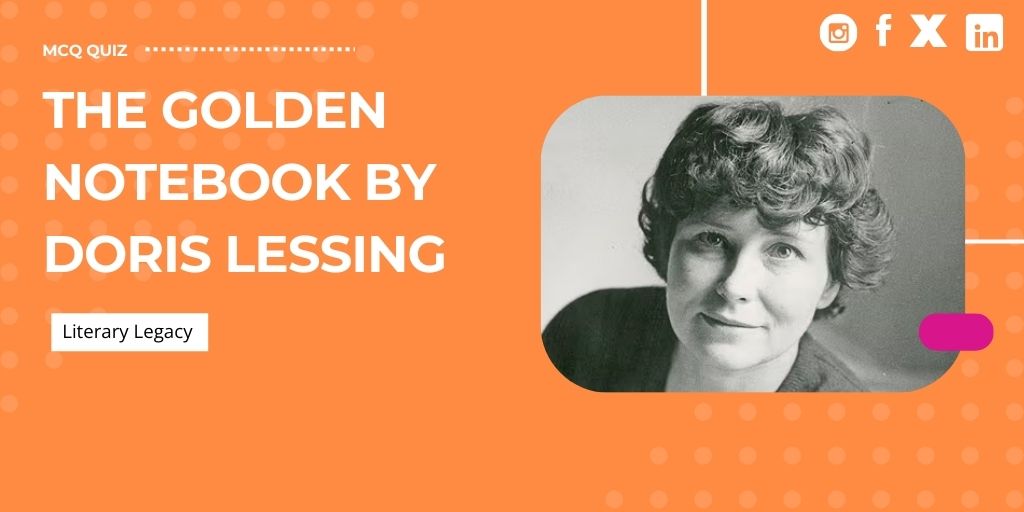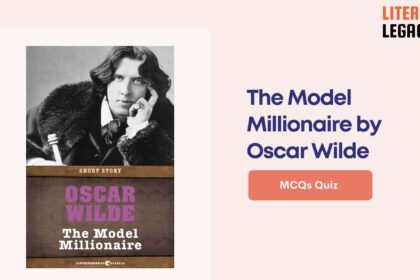1. Which character is described as the only genuine socialist among the Oxford airmen?
Choices
A) Willi Rodde
B) Jimmy McGrath
C) Ted Brown
D) Paul Blackenhurst
Answer: (C)
Ted Brown
Ted Brown is noted for being ‘the only genuine socialist’ of the Oxford airmen.
2. What is the primary occupation of Dr. West in the yellow notebook?
Choices
A) Poet
B) Editor
C) Medical doctor
D) Psychiatrist
Answer: (C)
Medical doctor
Dr. West writes the medical advice column at Women at Home magazine.
3. Who is referred to as Anna’s alter ego in the yellow notebook?
Choices
A) Julia
B) Maryrose
C) Ella
D) Patricia Brent
Answer: (C)
Ella
Ella is Anna’s alter ego and protagonist in her novel The Shadow of the Third.
4. Which character had a lengthy affair with Anna during the 1950s?
Choices
A) George Hounslow
B) Nelson
C) Saul Green
D) Michael
Answer: (D)
Michael
Michael, a married psychiatrist, had a lengthy and heartbreaking affair with Anna.
5. What was Charlie Themba’s condition many years into his activism?
Choices
A) He went insane
B) He retired from politics
C) He founded a charity organization
D) He became a prominent leader
Answer: (A)
He went insane
Charlie Themba went insane years into his activism and began accusing his allies of plotting against him.
6. What is the name of the protagonist in the yellow notebook, The Shadow of the Third?
Choices
A) Molly
B) Anna
C) Marie
D) Ella
Answer: (D)
Ella
Ella is the main character in The Shadow of the Third, a novel written by Anna.
7. What significant event occurs on the last day at the hotel?
Choices
A) Anna decides to leave her family.
B) George runs away with Marie.
C) Paul dies in an accident.
D) Ella publishes her first novel.
Answer: (C)
Paul dies in an accident.
Paul Blackenhurst dies in an accident on the airstrip the day before he elopes with Anna.
8. How does Ella react after Paul Tanner abruptly moves to Nigeria?
Choices
A) She feels devastated.
B) She publishes a novel about their affair.
C) She quickly finds another partner.
D) She decides to travel to Nigeria.
Answer: (A)
She feels devastated.
Ella is devastated after Paul moves to Nigeria, marking a significant turning point in her life.
9. Which character is known for making misogynistic rants?
Choices
A) Tommy
B) Paul
C) Michael
D) Richard
Answer: (D)
Richard
Richard is noted for his usual misogynistic rants during Anna’s visit.
10. What leads Anna to quit her job at the Party headquarters?
Choices
A) Michael pressures her to leave.
B) She is fired for her political views.
C) She receives a better job offer.
D) She feels that her work is meaningless.
Answer: (D)
She feels that her work is meaningless.
Anna realizes she is powerless and that her work at the Party headquarters is meaningless, prompting her to quit.
11. Tommy’s presence in Molly’s house is described as:
Choices
A) Dominating and consuming.
B) Passive and indifferent.
C) Welcoming and warm.
D) Joyful and uplifting.
Answer: (A)
Dominating and consuming.
Tommy’s presence in Molly’s house becomes dominating as he spends all his time reading and writing.
12. What conclusion do Anna’s fellow communists reach after Stalin’s death?
Choices
A) The party needs to change leaders.
B) The party is still worth supporting.
C) The party is growing stronger.
D) The party is irreparably corrupt.
Answer: (D)
The party is irreparably corrupt.
After a year of frenzied political activity, Anna’s fellow communists conclude that the party is irreparably corrupt.
13. What recurring theme does Anna face in her psychoanalysis sessions?
Choices
A) The violence in the world affects her writing.
B) Her relationship with communism.
C) Dealing with her family dynamics.
D) Finding meaning through her writing.
Answer: (A)
The violence in the world affects her writing.
Anna struggles with the violence in the world and its impact on her ability to write.
14. What does Anna feel about her recorded experiences in the blue notebook?
Choices
A) They accurately represent her feelings.
B) They are full of joy and satisfaction.
C) They are too detailed and complex.
D) They seem like false representations.
Answer: (D)
They seem like false representations.
Anna believes that the blue notebook’s record of facts feels like a false representation of her experiences.
15. What is the primary setting of Anna Wulf’s life in The Golden Notebook?
Choices
A) Rural England in the 1940s
B) New York City during World War II
C) Paris in the 1960s
D) Colonial Africa and London in the 1950s
Answer: (D)
Colonial Africa and London in the 1950s
The novel centrally concerns Anna’s life, memories, and writings during the 1950s in London and colonial Africa.
16. Which notebook contains Anna’s reflections on her relationship with the British Communist Party?
Choices
A) Black notebook
B) Blue notebook
C) Yellow notebook
D) Red notebook
Answer: (D)
Red notebook
The red notebook is where Anna recounts her ambivalence about her membership in the British Communist Party.
17. What does Anna express to Molly about her interest in writing?
Choices
A) She plans to abandon writing altogether.
B) She is currently writing a successful play.
C) She feels inspired to write multiple novels.
D) She has lost interest in writing another novel.
Answer: (D)
She has lost interest in writing another novel.
Anna shares her waning interest in writing another novel during her conversation with Molly.
18. What was a significant aspect of Anna’s experience while staying in Central Africa?
Choices
A) She formed a close friendship with a British soldier.
B) She fell into a long, sexless relationship with a German exile.
C) She became a renowned author in the region.
D) She actively participated in the local government.
Answer: (B)
She fell into a long, sexless relationship with a German exile.
Anna ended up in a long, sexless relationship with the German exile Willi Rodde while in Central Africa.
18. What color notebook represents Anna’s past in The Golden Notebook?
Choices
A) Red
B) Black
C) Blue
D) Yellow
Answer: (B)
Black
The black notebook is specifically used by Anna to explore her past experiences.
19. Which character is described as boisterous and worldly-wise in The Golden Notebook?
Choices
A) Anna
B) Molly
C) Richard
D) Tommy
Answer: (B)
Molly
Molly is characterized as a boisterous and worldly-wise actress in her interactions with Anna.
19. Which of the following best describes Anna’s relationship with Saul Green?
Choices
A) Predictable and straightforward throughout
B) Constantly harmonious with no conflicts
C) Unpredictable, swinging between affection and hostility
D) Non-existent until the end of the novel
Answer: (C)
Unpredictable, swinging between affection and hostility
Anna and Saul’s relationship is marked by extreme fluctuations between moments of peace and intense arguments.
20. How does Anna ultimately achieve a sense of unity and purpose?
Choices
A) By detaching from her emotions and experiences
B) By dismissing all parts of her identity
C) Through the integration of her fragmented notebooks
D) By adhering strictly to societal norms
Answer: (C)
Through the integration of her fragmented notebooks
Anna finds wholeness by consolidating her writings into the golden notebook, confronting her chaotic identity.
20. What does Tommy refuse from his father Richard?
Choices
A) Financial assistance for his education.
B) An offer to help find a job.
C) Advice about his current girlfriend.
D) An offer to move in with him.
Answer: (B)
An offer to help find a job.
Tommy comes downstairs to refuse his father’s offer to help find a job.
21. What aspect of Anna’s identity does the novel highlight as complex and fragmented?
Choices
A) The contradictions and multiplicities within herself
B) Her ability to isolate herself from societal issues
C) Her singular focus on her career as a writer
D) The distinct separation of her different relationships
Answer: (A)
The contradictions and multiplicities within herself
The novel illustrates that Anna’s identity is composed of various, often contradictory elements.
21. Which of the following themes is primarily explored through Anna’s four notebooks?
Choices
A) The triumph of capitalism over communism
B) The quest for romantic fulfillment
C) The fragmentation of identity and self-doubt
D) The development of friendships in exile
Answer: (C)
The fragmentation of identity and self-doubt
Anna’s notebooks illustrate themes of fragmented identity and her struggle with self-doubt and contradiction.
22. What is the significance of the golden notebook in Anna’s journey?
Choices
A) It represents the ultimate rejection of her past relationships.
B) It symbolizes her return to traditional narrative styles.
C) It acts as a consolidation of her fragmented experiences into one narrative.
D) It serves as a tool for Anna to isolate herself further.
Answer: (C)
It acts as a consolidation of her fragmented experiences into one narrative.
The golden notebook allows Anna to integrate her experiences rather than segregate them.
23. What theme does Anna’s realization about ‘multiple Sauls and multiple Annas’ convey?
Choices
A) The simplicity of human relationships
B) The complexity of identity and perspective
C) The avoidance of deep emotional connections
D) The importance of maintaining a singular self
Answer: (B)
The complexity of identity and perspective
This realization underscores the nuanced nature of identity and the perspectives we adopt.
24. What does the character Milt symbolize in Anna’s life?
Choices
A) A destructive force that leads to more chaos
B) An indifferent presence who ignores her struggles
C) A romantic interest who challenges her independence
D) A stable, caring figure who represents security
Answer: (D)
A stable, caring figure who represents security
Milt is portrayed as someone who provides care but also has a complex relationship with women.
25. What does Anna’s mental breakdown symbolize throughout The Golden Notebook?
Choices
A) A peaceful acceptance of her circumstances
B) The resolution of personal conflicts and clarity of purpose
C) The fragmentation of both society and personal identity
D) The triumph of the individual over societal constraints
Answer: (C)
The fragmentation of both society and personal identity
Her breakdown reflects broader themes of societal disconnection and personal chaos.
26. Which of the following statements encapsulates the conclusion of Anna’s storytelling?
Choices
A) It suggests that truth can only be expressed through controlled narratives.
B) It proposes that personal experiences should be compartmentalized.
C) It illustrates that embracing contradictions leads to personal wholeness.
D) It affirms that singular identity is attainable.
Answer: (C)
It illustrates that embracing contradictions leads to personal wholeness.
Anna’s journey concludes with the understanding that recognizing and accepting contradictions can enhance coherence.
27. What does Anna realize about her notebooks over the course of the narrative?
Choices
A) They only serve to confuse her more about her relationships.
B) They effectively capture her true feelings and identity.
C) They represent her struggle with fragmentation and identity.
D) They must always remain separate to maintain her sanity.
Answer: (C)
They represent her struggle with fragmentation and identity.
Anna comes to understand that her notebooks symbolize her efforts to compartmentalize her thoughts and feelings, rather than truly expressing her identity.
28. What does the golden notebook symbolize for Anna?
Choices
A) The unification of her different aspects into one identity.
B) The confinement of her multiple identities.
C) The completion of her successful writing career.
D) The chaos and madness of her fragmented self.
Answer: (A)
The unification of her different aspects into one identity.
The golden notebook represents Anna’s attempt to consolidate her fragmented identities into a single, unified self.
29. What does Anna’s decision to write everything in one place signify about her view on contradiction?
Choices
A) Contradiction should be avoided at all costs.
B) Contradiction is a sign of instability.
C) Embracing contradiction is a path to wholeness.
D) Writing about contradictions is pointless.
Answer: (C)
Embracing contradiction is a path to wholeness.
Anna’s choice to embrace contradiction indicates that she believes in confronting her chaotic nature as a way to heal and achieve wholeness.
30. How does Anna’s approach to her identities reflect a common misunderstanding about madness?
Choices
A) She believes that a single identity is healthier.
B) She views fragmentation as a way to maintain sanity.
C) She recognizes multiplicity as normal and healthy.
D) She thinks that embracing chaos leads to delusion.
Answer: (A)
She believes that a single identity is healthier.
Anna’s struggle illustrates the misconception that a single identity is synonymous with mental health, rather than recognizing the complexity of being multiple.
31. Which character functions as a pivotal influence in Anna’s decision to confront her feelings through writing?
Choices
A) Tommy
B) Richard Portmain
C) Janet Wulf
D) Molly Jacobs
Answer: (A)
Tommy
Tommy advises Anna to stop compartmentalizing her thoughts, prompting her to confront her fragmentation directly.
32. What theme is suggested by Lessing regarding the nature of madness and identity?
Choices
A) Madness is the result of too much self-reflection.
B) Embracing one’s complexity is a healing process.
C) Identity should always be fluid and changeable.
D) Madness arises from the acceptance of a single identity.
Answer: (B)
Embracing one’s complexity is a healing process.
Lessing posits that embracing and reconciling one’s multiple identities is integral to overcoming delusion and achieving mental well-being.
33. What describes Anna Wulf’s relationship with her character Saul?
Choices
A) They completely disagree on all artistic views.
B) Their identities begin to merge through their writing.
C) Saul views Anna only as a partner in his writing.
D) They share a simple and straightforward friendship.
Answer: (B)
Their identities begin to merge through their writing.
As Anna confronts her madness, her relationship with Saul deepens, leading to a blending of their artistic identities.
34. What does Anna’s experience with writer’s block symbolize in the context of her notebooks?
Choices
A) Her emotional pain being repressed.
B) Her failure as a novelist.
C) Her lack of interest in writing altogether.
D) A necessary step in the writing process.
Answer: (A)
Her emotional pain being repressed.
Anna’s writer’s block represents her struggle with emotional suppression, which she must confront to progress in her writing.
35. What ultimately signifies Anna’s healing journey throughout the narrative?
Choices
A) Her abandonment of artistic pursuits altogether.
B) Her compilation of all her notebooks into one.
C) Her decision to write exclusively about her past.
D) The completion of her second novel, Free Women.
Answer: (D)
The completion of her second novel, Free Women.
The completion of Free Women serves as a marker of Anna’s healing, illustrating her growth from fragmentation to wholeness.
36. What is the primary focus of Anna Wulf’s four private notebooks in The Golden Notebook?
Choices
A) Studies of her socialist friends and their ideologies
B) Detailed accounts of her travels around the world
C) Reflections on her past relationships and personal struggles
D) Projects for potential future novels
Answer: (C)
Reflections on her past relationships and personal struggles
Anna’s notebooks serve as a reflection of her life, relationships, and internal conflicts.
37. How does Anna perceive the reception of her first novel, Frontiers of War?
Choices
A) She believes it is her best work yet
B) She is indifferent towards readers’ opinions
C) She feels it misrepresents her experiences
D) She fully embraces it as a success
Answer: (C)
She feels it misrepresents her experiences
Anna considers her first novel inadequate and naïve despite its success.
38. What is the main implication of Anna’s waning interest in writing another novel?
Choices
A) Her belief that novels are no longer relevant
B) Her desire to focus on her personal diary entries
C) Her newfound commitment to the Communist Party
D) Her struggle with mental health and creative block
Answer: (D)
Her struggle with mental health and creative block
Anna’s ambivalence towards writing highlights her inner turmoil and conflict.
39. Which character embodies the conflict Anna feels about leftist politics?
Choices
A) Tommy, Molly’s son
B) Marion, Richard’s current wife
C) Willi Rodde, the German exile
D) Richard, Molly’s ex-husband
Answer: (D)
Richard, Molly’s ex-husband
Richard’s disdain for leftist politics represents a tension that Anna grapples with in her own identity.
40. What social environment does Anna find herself in during her time in Central Africa?
Choices
A) An exclusive club of wealthy expatriates
B) A secluded writer’s retreat
C) A strict Catholic community
D) A casual group of white socialists
Answer: (D)
A casual group of white socialists
Anna’s social life revolves around drinking with a diverse group of white socialists.



